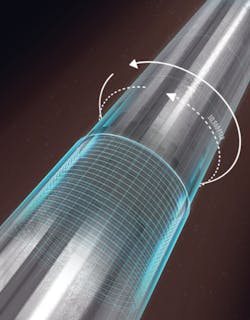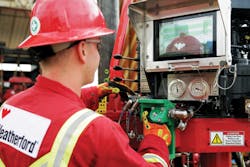Automation advance delivers safer, more certain casing connections
Industry’s first automated makeup and autonomous evaluation technology
Scott McIntire
Weatherford
Conventional wisdom has taught operators that while mistakes during casing and completion-string makeup are unacceptable, they still do occur regularly. It is common, and almost expected, to have a few rejected connections—those that for one reason or another do not meet the required makeup parameters—during a casing running job.
Even simple errors, such as misreading a torque-turn graph, keying in a wrong data entry, or exceeding the reference torque value during spin in, raise the opportunity for an improper connection makeup. Any risk to connection integrity ultimately risks the integrity of the well, forcing the operator to deploy time-consuming and costly remediation solutions that delay production.
The AutoTong’s computer-regulated makeup and built-in evaluation combine to improve connection integrity. (All images Weatherford)
Weatherford approached the challenge of connection-integrity mistakes by taking what is currently a manpower-intensive process and automating it. The company developed its AutoTong system—the industry’s first automated makeup and autonomous evaluation technology—to deliver connection integrity with robot-like control and precision. By adding automation to connection makeups, the system nearly removes any human influence, and associated human error, from the casing running process.
Today’s connection challenges
A common operator complaint about current connection makeup processes relates to operational inefficiencies. Multiple individual components must be assembled on the rig floor and connected through both hardware and software communication, which translates to lengthy rig-up and rig-down times.
Current casing running operations also suffer from slow joint run rates, thanks largely to the role that people have to play in making connections. Rig personnel are responsible for manually entering tong-specific data, and a missed keystroke can result in a catastrophic connection failure because of over- or under-torqued pipe. In addition, an operator has to manually operate the tong—when it starts and stops, how fast it rotates to make the connection—which introduces additional risks of shooting past or falling short of the target torque. Inconsistent interpretation of the torque-turn graph is also a common occurrence, with different operators on different shifts responsible for reading the graphs and assessing if connections have been made up properly.
Personnel requirements are another common concern. Conventional casing running processes are largely manual, with four to five people moving around on the rig floor at the same time. This not only raises serious HSE risks, but it adds significant costs when one factors in day rates, onsite accommodations, and transportation to and from the rig.
An improper makeup can add significant costs to well construction, with a price tag that varies depending on when and where the problem was caught. Even if a nonconforming makeup is identified as soon as it is completed on the rig floor, operational efficiency is still negatively impacted. The onsite operator has to evaluate the graph, the rig crew has to break out the connection and lay out the upper joint, and the lower joint has to be pulled and replaced—all of which contribute to lost time and a loss of operational momentum.
The problem becomes more costly and complicated if the nonconforming makeup is improperly evaluated and the connection makes its way downhole as part of the completion string. A leaking completion connection impacts well integrity and requires costly intervention and recovery efforts that could include running a log to identify the precise position of the leak, deploying a workover rig to perform the intervention services to seal the leak. Worse yet would be pulling the completion and recompleting the well. The cost to the operator climbs exponentially when one factors in the revenue losses in deferred production when the well is offline.
Using AutoTong to control and evaluate the final make-up stage dramatically improves safety by minimizing the number of personnel on the rig floor and essentially eliminating the risk of connection failures.
Revolutionizing connection makeups
The automated system makes up connections in a more controlled manner and evaluates each make up with increased accuracy which vastly improves connection integrity.
The AutoTong simplifies connection makeups in several key ways. Only one operator is required to manage the tong and the incorporated torque turns monitoring system. The operator uses the unit’s hand-grip control, which provides simple operation via a thumb joystick, to spin the pipe at high speed to an initial, preprogrammed reference torque value. A tablet mounted on the tong displays a torque/turns graph and system settings, and enables the operator to input job data, as needed. The unit automatically stops the tong when that reference torque value is reached, which is critical with chrome alloy completion strings as it prevents the operator from galling or potentially over-torqueing the connection.
The operator then changes to the low-speed/high-torque setting and presses the start button on the hand-grip control, which activates the tong-mounted computer to automate connection makeup to the final torque. The computer continually monitors the torque measured by two electronic load cells and adjusts the rotational speed of the string accordingly to ensure a smooth connection. The values from these two load cells are compared to one another to ensure they are properly measuring the torque applied to the connection, which provides sensor redundancy.
The computer is pre-programmed with the optimum makeup torque for each connection. As the connection approaches final makeup torque, the computer uses a proprietary speed-control to automatically slow the rotation to stop at the final torque with digital precision.
This smooth, controlled process replaces the traditional way an operator manually controls the hydraulics powering the tong and dictates how fast or slow to make the connection. These traditional power tongs include a hydraulic dump valve which cuts pressure to the tong when the optimum torque is achieved. This sudden stop typically raises the risk of over-torqueing the connections and is not as accurate as the speed-controlled system.
Ensuring connection conformance
As soon as each makeup is completed, the system’s second component, the AutoEvaluate software, automatically analyzes connection data to ensure conformance to OEM specifications. In a matter of seconds, the software’s proprietary evaluation algorithms verify connection is properly made up to the OEM criteria, thus eliminating the human errors and inconsistency associated with subjective graphical interpretations.
Connections are interpreted using 10 times more data points than the human eye can see, virtually eliminating any uncertainty about connection integrity. And if the software does reject a connection, its troubleshooting advisor application identifies the root cause of the problem and recommends corrective action.
The system’s automated makeup and evaluation capabilities yield several distinct benefits, beginning with safety improvements due to the reduction of personnel on the rig floor. Along with this drop in headcount also comes a decrease in well construction costs. The system is shipped as an all-in-one unit and installed in a single step, which reduces the installation time, costs, and complexity of traditional makeup systems.
The precise control and error-free evaluation of string connections deliver additional cost savings and improve safety by reducing the number of rig personnel from six to four. And by providing consistent makeup, accurate analysis, and minimal manual data entry, the system ensures an overall more efficient and cost-effective makeup process, with fewer damaged connections and laid out joints.
Ultimately, the greater assurance of consistent connection quality through automation translates to improved well integrity for the life of the asset. Operators not only bring their wells into production more quickly, but also they are assured longer, uninterrupted production thanks to a low risk of tubing leaks downhole.
Proven on the rig
The AutoTong has been run on a number of rigs around the world since its introduction in October 2017.
An operator completing an offshore-shelf oil well near Baku was the first to use the technology as a means of enhancing rig floor safety and improving makeup efficiency. The operator wanted to minimize the number of personnel on the floor while running 4½- and 7-in. premium, chromium-alloy completion tubulars to a target depth (TD) of 20,341 ft (6,200 m). They aimed for error-free connections throughout the completion string, which could be confirmed with accurate connection-makeup graph evaluation. Each connection was to be made up to OEM specifications, with minimal marking.
A Weatherford field team deployed the full system to the drilling rig located in 577 ft (176 m) of water, and rigged it up quicker and more seamlessly than conventional equipment. The system required only a single operator for the tong, eliminating the need for a separate joint-analyzed makeup unit and technician.
The technician used the system’s hand-grip control to spin the connection to the reference torque, after which he changed to the low-speed/high-torque setting and pressed start. The AutoTong system took over, automating the final makeup and slowing the rotation of the joint to its final torque target. The integrated evaluation software then automatically analyzed the makeup data to ensure that the connection conformed to OEM specifications.
The technician repeated this process to run all 532 premium, chromium-alloy completion tubulars with zero nonproductive time related to this equipment. All connections were made up error-free and to OEM specs, as confirmed by the evaluation software, which approved the makeup graphs by automatically checking the data against the OEM criteria. In addition to flagging any non-optimal connections before they were run downhole, the system increased tubular-running efficiency over conventional methods.
The system ran each joint with minimal markings and helped the operator meet its enhanced rig safety metrics. Encouraged by the success of this initial run, the operator has since used the system to safely and efficiently speed up its tubular makeup operations on several other wells.
The success of the AutoTong system on land and shallow-water rigs has prompted Weatherford to keep innovating. Building on the automation advances of the original system, the company is now developing a mechanized AutoTong system for safer and more efficient tubular running in deepwater operations. Designed for applications on large offshore rigs and drillships, the new system will integrate more sensors and programing into the tong to enable complete automation of the makeup process with the press of a button on a remote HMI unit which could be operated from the driller cabin. Further development will allow control of the makeup process into the rig’s control systems. This promises to not only improve the speed of deepwater tubular running but also enhance safety by reducing required rig personnel down to just one engineer for the entire casing-running process.


